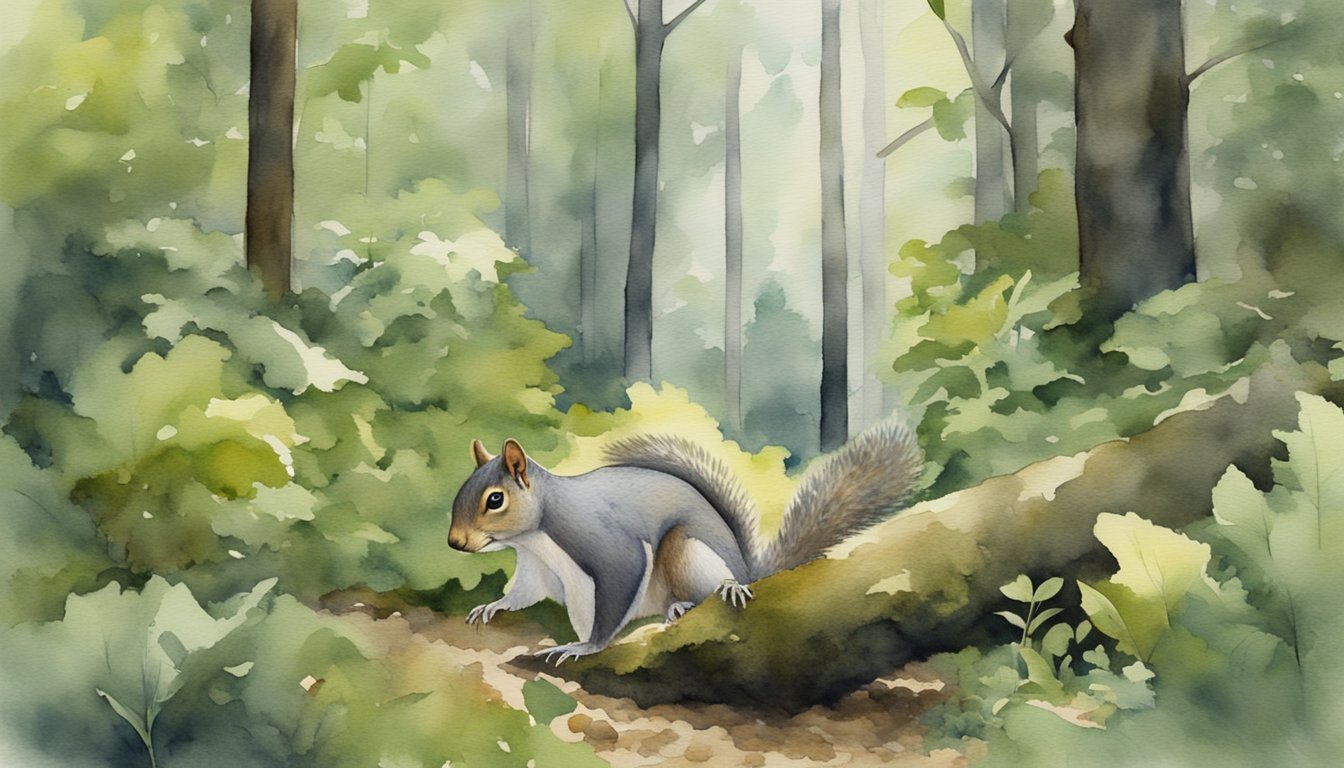Eastern Gray Squirrel Basics
The Eastern Gray Squirrel is an intriguing species known for its adaptability and characteristic bushy tail. This section delves into the fundamental aspects of the animal, from its identification and physical form to its behavior and life cycle.
Species Overview
The Eastern Gray Squirrel, Sciurus carolinensis, is a common member of the family Sciuridae. This species of tree squirrel is indigenous to North America and has also been introduced to other parts of the world. The gray squirrel plays a vital role in seed dispersal, aiding in the regeneration of forests.
Physical Characteristics
Adult Eastern Gray Squirrels typically measure between 38 to 52 centimeters (15 to 20 inches) in length, including their tail. They display a mix of gray and white fur, with hues ranging from black to brown. Their most recognizable feature is the bushy tail, which helps balance during arboreal activity and protects against harsh weather.
Natural Habitat
These squirrels are highly adaptable and can be found in an array of environments, from hardwood forests to urban areas. They prefer locations rich in trees such as oaks and hickories, using the branches to travel and leaves to help form their nests, known as dreys.
Diet and Foraging Behavior
The diet of an Eastern Gray Squirrel is diverse, including acorns, hickory nuts, seeds, buds, berries, and even the occasional insect. They are known for their habit of foraging for food sources and burying them in various locations for winter use.
Reproduction and Lifespan
The gray squirrel’s breeding season can occur twice a year, with a gestation period of about 44 days. Females can give birth to two litters each year, averaging two to four young per litter. In the wild, these squirrels may live up to 12 years.
Behavior and Activity
Eastern Gray Squirrels are diurnal, meaning they are active predominantly during the day. They are not known to hibernate but will stay in their nests during extremely cold weather. Their behavior includes adept climbing, leaping, and skillful problem-solving to access food. Vocal communication is common, and the sense of smell is crucial for relocating hidden caches of food.
Ecological Impact and Conservation

The ecological impact of the eastern gray squirrel is significant, involving aspects such as population dynamics, environmental interactions, threats, and conservation efforts. Understanding these components sheds light on the squirrel’s role within various ecosystems.
Population and Distribution
The eastern gray squirrel, native to North America, boasts a considerable population that spans the United States and Canada. Their range reflects their adaptability, thriving within diverse forest ecosystems from rural woodlands to urban parks.
Interaction with Environment
Spring and summer are crucial times for eastern gray squirrels as they engage in nut caching and constructing leaf nests among the trees. Their intricate relationship with the environment can influence tree planting patterns and assist in seed dispersal, essential for the regeneration of vegetation.
Impact on Ecosystems
As an invasive species in Europe, the grey squirrel poses a threat to native ecosystems, competing with local squirrels and predation on seeds and tree squirrels. Their presence is notorious for altering habitats and affecting the population of certain bird species due to their nest predation tendencies.
Threats and Conservation Efforts
Despite their adaptive success, eastern gray squirrels face threats from habitat loss and predation by raccoons, foxes, and bobcats. Conservation efforts are ongoing, with a focus on maintaining population balance and ensuring the viability of their habitats both in native and introduced regions.
Human Influences and Urban Adaptation
In urban areas, eastern gray squirrels have become a familiar sight, often seen foraging in backyards and parks. Human influence has facilitated their urban adaptation, leading to shifts in squirrel behavior and population dynamics in cities compared to their forest-dwelling counterparts.
Role in Popular Culture
The eastern gray squirrel has left a notable imprint on popular culture, often depicted as the quintessential squirrel in media. The Greek root of their name, ‘skia’ for shadow and ‘oura’ for tail, aptly describes their characteristic bushy tail that has become an endearing symbol in itself.
Here is the information from the search results:
- The eastern grey squirrel is considered one of the most damaging invasive alien species in Europe, with negative effects on native ecosystems Negative effects on ecosystems.
- Conservation Challenges: Protecting Eastern Gray Squirrel Populations Conservation challenges.
- Eastern Gray Squirrel Ecology and Interactions with Western Gray … Eastern and western gray squirrel interactions.
- Health Status of the Eastern Grey Squirrel (Sciurus carolinensis) Health status and invasive status.
- How the Eastern Grey Squirrel became our urban neighbors Urban adaptation.

